With the world moving towards digital-first connectivity, eSIM (embedded SIM) technology is rapidly emerging as the new approach for mobile communications.
Mobilise estimates that total addressable spending across the travel eSIM market will expand from $1.7 billion in 2024 to between $8.7 billion and $10 billion by 2028. This demonstrates just how fast this sector is developing and the wealth of opportunities it offers. As the world continues its global march toward seamless connectivity and remote device management, developing an eSIM app in 2025 is an enormous opportunity for tech innovators, telecom providers, and startups to be at the forefront of this transformative technology.
In this blog, we will discuss the entire workflow behind developing an eSIM app. We cover every key step, from planning to picking the right tech stack. You’ll also get an idea of regional development costs. We’ll delve into real-world case studies like Airalo. This guide is perfect for developers, entrepreneurs, and tech aficionados. You will learn how to create a secure and scalable eSIM platform with a user-friendly interface. Get ahead in the future of worldwide mobile connectivity.
Steps To Develop An E-Sim Platform
Building an eSIM platform isn’t just about jumping on a tech trend—it’s about meeting the growing demand for seamless, global connectivity. As more users shift away from physical SIM cards, a well-designed eSIM app can offer flexibility, speed, and control in a digital-first world. Whether you’re targeting travelers, digital nomads, or everyday smartphone users, laying the right foundation is key.
Here’s a step-by-step guide to help you develop a secure, scalable, and user-friendly eSIM platform from the ground up.
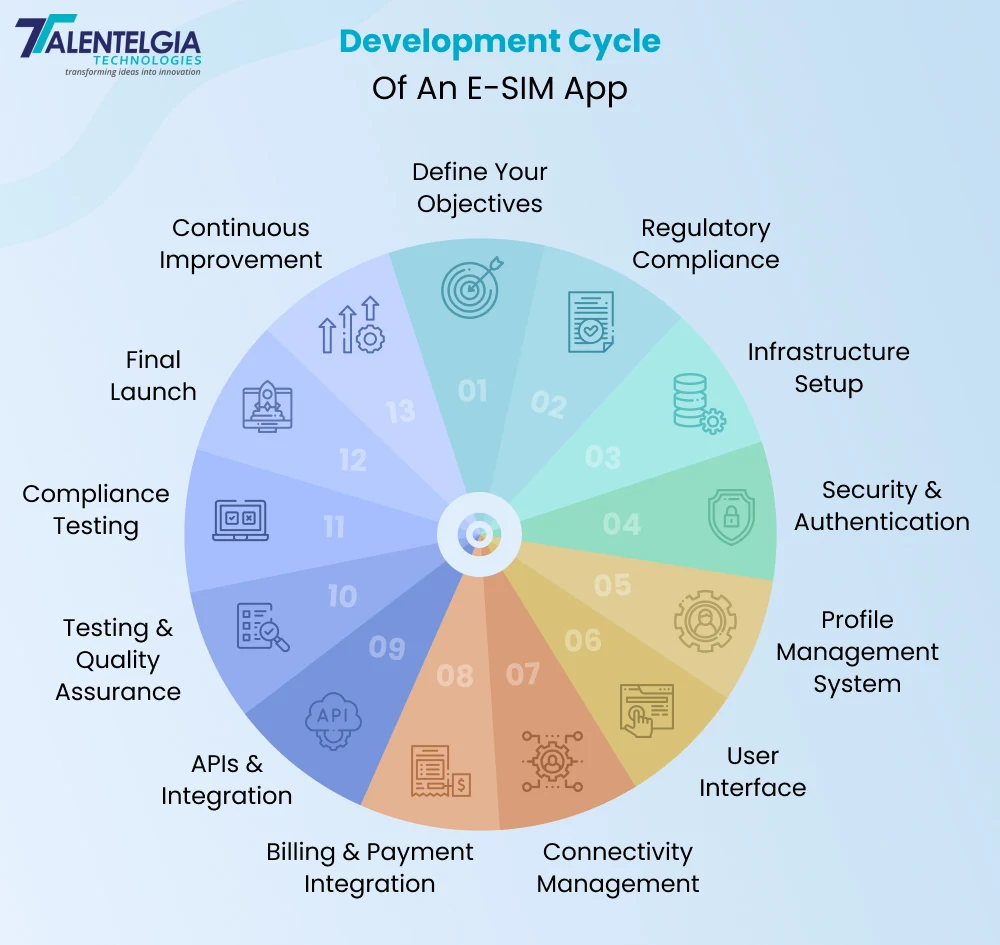
1. Define Your Objective
Establishing a solid strategic framework by defining your goals is essential before you move on to your eSIM mobile app development. Start by figuring out who you’re making the app for — frequent travelers, remote workers, diginoms, or everyday users who need internet access on the go.
Ask yourself:
- Who is most likely to benefit from a digital SIM experience?
- What pain points does your app solve for these users?
- Will the app be monetized through subscriptions, pay-per-use, or partnerships?
Do thorough market research to know your competition. What are they doing well? Where are they falling short? Many successful eSIM apps, for example, deliver fast activation times and carrier flexibility but are missing real-time usage insights or the ability to manage multiple devices, gaps that your app could fill.
You could also run a feature comparison to see which capabilities are most appealing to your audience, whether in-app carrier switching, transparent pricing, or auto-activation. Based on these findings, define a phased development plan.
Ensure your app:
- Works seamlessly across devices and networks.
- Meets local and international compliance requirements (e.g., FCC or ETSI).
- Offers a user experience that adapts as needs evolve.
2. Regulatory Compliance
Regional telecom regulation compliance is critical in eSIM app development. eSIM technology is subject to tight regulations in contrast with conventional SIM applications. Moreover, non-compliance with these requirements can lead to serious legal complications or complete unavailability in certain markets.
Start by asking:
- What are the telecom compliance requirements in your target countries?
- Which governing bodies oversee eSIM regulations in those regions?
- How can early compliance planning reduce future risks?
For example, in the United States, the Federal Communications Commission (FCC) enforces strict policies around SIM technologies. This focuses on consumer protection and data security. In Europe, the European Telecommunications Standards Institute (ETSI) governs how mobile connectivity technologies, including eSIMs, are deployed and managed.
3. Build a Robust Infrastructure
Your infrastructure plays a vital role in the primary development of an effective eSIM app. Your environment should involve security servers, a responsive database , and reliable communication channels. Pick a reliable hosting provider that has an excellent history of performance and uptime. Heavy scaling of data should be available automatically since you will be getting many clients.
Maintain the integrity of all sensitive data — establish secure storage with robust encryption and authentication protocols. A solid infrastructure ensures an optimal performance tail with minimal downtimes while delivering a better user experience, which contributes to building trust and long-term reliability as your app continues to grow. You can start by resolving the following questions:
- How do you ensure uptime during heavy usage spikes?
- Is your data encrypted and protected against unauthorized access?
- Can your infrastructure handle global scalability and performance needs?
4. Strengthen Security
Security is critical for any eSIM app handling personal and telecom-related data. Unauthorized access or data leaks can severely damage trust. Implement end-to-end encryption during data storage and transmission. Use multi-factor authentication to verify users securely. Regularly perform security audits to detect and fix vulnerabilities. Align your protocols with GSMA encryption and authentication standards. Secure data storage is a must for preventing breaches.
Stay updated with evolving cybersecurity practices. Apply routine updates to protect your app from the latest threats. Educate users on simple steps to protect their information. A secure app fosters trust and ensures long-term reliability.
Given the security readiness of your app, testing is a critical aspect:
- Usability Testing: Confirms that users have access to the app and can navigate it easily.
- Compatibility Testing: Verifies your app runs seamlessly across all networks and devices.
- Security Testing: Find vulnerabilities to fix before deployment to make exploitation impossible.
- Performance Testing: Assesses app stability and responsiveness under realistic loads.
5. Create a Robust Profile Management System
Well-defined profile management is a necessity for any eSIM app. It acts as a hub for deleting and managing multiple eSIM profiles from a variety of devices. Your app has to support remote provisioning and profile switching on demand. Allow users to activate or deactivate profiles without changing SIM cards. It provides a seamless and modern user experience.
Let users securely update their data in the app. Make sure the data is secured and complies with privacy legislation. User confidence is built with a system that is compliant and helps mitigate legal issues. Finally, good profile management today makes for an easy user experience and contributes to long-term value.
Key Capabilities to Include:
- Remote Activation/Deactivation: Users can switch carriers anytime without hardware changes.
- Secure Information Management: Protect user data with encryption and privacy compliance.
- Multi-Device Profile Support: Manage several profiles on different devices with ease.
6. UX/UI Design
A clean and intuitive user interface design and user experience design is key to user satisfaction. Make sure users can access their profiles quickly and easily. Simplify plan selection and changes. Show real-time usage and billing in a clear format. Offer multi-language support to serve a global audience. Allow users to customize the app interface to suit their needs. Send relevant notifications and updates instantly. Include a help center and accessible support options.
Here are some must-have UI and accessibility features:
- Can users change plans or check usage in under 3 clicks?
- Is your design optimized for all age groups and devices?
- Does the app support voice commands or screen readers?
7. Set Up Smart Connectivity Management
Your platform should easily connect to various networks. Manage data flow smoothly across devices and carriers. Optimize network usage with intelligent switching. Cut roaming costs by auto-connecting to local networks. Ensure strong coverage even in low-signal areas. Add real-time monitoring to detect and fix issues fast. Ask yourself the following questions:
- Can the app switch carriers without dropping the connection?
- Is network performance consistent across all locations?
- How fast can issues be identified and fixed?
8. Add Billing and Payment System
Let’s be honest — no one likes confusing bills. That’s why billing through your eSIM platform should be simple, clear, and reliable. Begin tracking real-time usage so that users know precisely what they’re paying for. Automate: Generate an invoice to keep free time and avoid errors.
Then, provide plenty of payment methods—credit or debit cards, mobile wallets such as Apple or Google Pay, and even shop-by-installment options. The better user experience you can offer, combined with the flexibility.
And pricing should be 100% transparent. No surprise fees, no nasty surprises. Add usage breakdowns and visual trackers so they can easily track their spending.
And remember: a seamless, safe billing system not only enhances usability; it fosters trust, too. When customers are in charge of their payments, they are far more likely to stay.
9. Add APIs and enable seamless integration
APIs (Application Programming Interfaces) are like the glue connecting your eSIM platform to other systems. API development services allow your platform to interact with mobile networks, billing systems, and user-facing apps.
Make your APIs clean, self-explanatory, and easy to be productive with. This helps developers to get integrated faster with your platform. Using the right APIs, you can integrate your system with many devices and networks seamlessly.
APIs allow service providers to plug into your platform without having to adjust their infrastructure. This results in quicker onboarding and cheaper setup costs. Additionally, secure APIs maintain data security and regulatory compliance.
Managing eSIM profiles, handling payments, as well as syncing usage data—APIs do all this in the background. Then, start building flexible, secure, and scalable APIs.
10. Test Your Platform
Make sure to run comprehensive testing before launching your eSIM app. This will make sure your platform runs error-free for all users.
Functional testing should be your first step. Ensure that every feature has its intended effect — no bugs, no errors. Next, do performance testing. Will thousands of users not slow you down?
It is also very important to perform Security testing. Search for any weaknesses hackers could exploit. Patch them before going live to protect user data.
Compatibility testing should also not be overlooked. Test the performance of your app on a range of devices, operating systems, and networks. Your platform needs to run smoothly, regardless of the device someone is accessing it from.
Simply put, solid quality assurance leads to fewer surprises after launch. It keeps users happy, lowers costs, and improves your platform’s fidelity from day zero.
11. Check For Regulatory Compliance
ESIM tech moves fast , but regulations can keep up. This is why compliance testing needs to be conducted before launch.
Ensure that your platform adheres to all industry standards, such as GSMA guidelines and data protection laws. These rules aren’t mere formalities; they ensure that your app is secure, fair, and legal to use.
By testing for compliance now, you’re sparing yourself delays, legal trouble, or fines down the line. It also enables you to establish credibility and trust with your users. They’ll feel more secure knowing their data is being managed correctly.
In conclusion, compliance testing makes sure that your eSIM app is safe and future-ready. Part of every development checklist, every time, always.
12. Tech Stack for e-Sim App Development
The tech stack is one of the most important building blocks when it comes to building an eSIM app. The tech stack you choose has significant implications not only for speed and performance but also for how scalable, secure, and maintainable your app becomes over time.
Whether you’re developing a native app for a platform or going cross-platform to include Android and iOS users using the same app, your stack should support flexibility, smooth performance, and strong integration capabilities.
Native Development Tech Stack
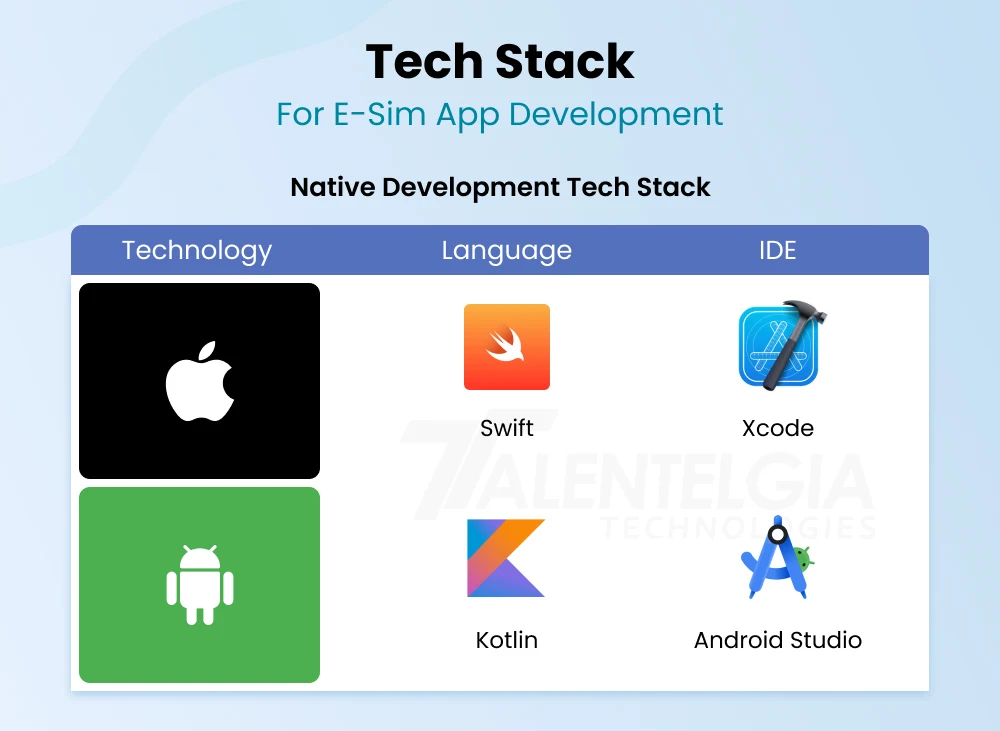
- iOS App Development
- Swift: The language Apple loves to use for iOS. It’s fast, secure, and clean—exemplary for performance-driven apps.
- Xcode: Apple’s official IDE. From UI design tools to debugging and testing environments, it provides everything.
- Android App Development
- Kotlin: Android apps’ best-known language. It’s compact, economical, and integrates nicely with Java.
- Android Studio: It offers smart editing tools, performance profilers, and emulators to make testing across devices easy.
- Integrating with Mobile Carriers
A successful eSIM app must work seamlessly with mobile network operators (MNOs). That means integrating key tools and standards:
- Carrier APIs: These help manage user profiles, eSIM activation, switching, and deactivation.
- GSMA-Compliant Libraries: GSMA sets global standards for eSIMs. Using libraries that follow these specs makes it easier to comply and integrate.
- Payment Gateway APIs: Enable secure payments for data plans. Stripe, Razorpay, or PayPal are common options for global or regional transactions.
Case Study: Airalo
One of the most successful implementations of a global low-infrastructure eSIM app is Airalo. The company was highly praised for providing inexpensive eSIM data packs for more than 200 countries, making it easier to stay connected, even while traveling abroad. One of the leading reasons behind the success of Airalo is its tech stack and integration choices.
Airalo possibly used a cross-platform approach using Flutter or React Native to ensure fast development and wide device coverage. This enabled them to keep a single codebase and output on both iOS and Android platforms without a hitch. The app’s performance is incredibly smooth, thanks to the clean and intuitive user interface.
Airalo’s platform is also integrated with multiple carrier APIs to handle the eSIM activation, provisioning, and switching between mobile networks across regions. These integrations are based on GSMA standards, providing safe and compliant communication between the application and telecom providers.
Financially, Airalo supports local payment options such as credit/debit cards, PayPal, Google Pay, and Apple Pay, ensuring seamless transactions for users worldwide. Scalability and trust, and satisfaction among users have been achieved by their ability to combine technical excellence with worldwide usability.
Cost Of Developing An E- SIM App- Regional
When developing an eSIM app, one of the biggest factors to consider is regional development cost. On average, the hourly development rates range from $15 to $250, depending on the location and expertise of the team. Below is a quick overview of hourly rates across different regions:
| Region | Cost Range (per hour) |
|---|---|
| Latin America | $25 – $75 |
| Central & Eastern Europe | $30 – $80 |
| South Asia | $15 – $50 |
| Southeast Asia | $20 – $60 |
| North America | $100 – $250 |
Conclusion
The future of global connectivity is already here, and eSIM apps are no longer merely a novelty; they’re quickly becoming a necessity. All you are left to do is tap into a burgeoning market, simplify experiences for users, and build a future-ready product. But success in this space is not merely about riding a trend; it’s about making some thoughtful choices all along the way, from infrastructure to security to user interface to regulatory compliance.
For entrepreneurs and businesses that are open to sowing into innovation, the eSIM market is an extraordinary combination of growth, scalability, and cross-border impact. If you are a telecom disruptor or a startup powering digital mobility, start building, scaling, and leading now — you could hardly find a better time to be able to do so.
So the question is no longer if you need to be building an eSIM application — it’s what part of today can you get started?


 Healthcare App Development Services
Healthcare App Development Services
 Real Estate Web Development Services
Real Estate Web Development Services
 E-Commerce App Development Services
E-Commerce App Development Services E-Commerce Web Development Services
E-Commerce Web Development Services Blockchain E-commerce Development Company
Blockchain E-commerce Development Company
 Fintech App Development Services
Fintech App Development Services Fintech Web Development
Fintech Web Development Blockchain Fintech Development Company
Blockchain Fintech Development Company
 E-Learning App Development Services
E-Learning App Development Services
 Restaurant App Development Company
Restaurant App Development Company
 Mobile Game Development Company
Mobile Game Development Company
 Travel App Development Company
Travel App Development Company
 Automotive Web Design
Automotive Web Design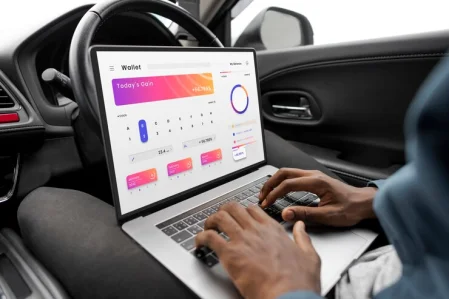
 AI Traffic Management System
AI Traffic Management System
 AI Inventory Management Software
AI Inventory Management Software
 AI Software Development
AI Software Development  AI Development Company
AI Development Company  AI App Development Services
AI App Development Services  ChatGPT integration services
ChatGPT integration services  AI Integration Services
AI Integration Services  Generative AI Development Services
Generative AI Development Services  Natural Language Processing Company
Natural Language Processing Company Machine Learning Development
Machine Learning Development  Machine learning consulting services
Machine learning consulting services  Blockchain Development
Blockchain Development  Blockchain Software Development
Blockchain Software Development  Smart Contract Development Company
Smart Contract Development Company  NFT Marketplace Development Services
NFT Marketplace Development Services  Asset Tokenization Company
Asset Tokenization Company DeFi Wallet Development Company
DeFi Wallet Development Company Mobile App Development
Mobile App Development  IOS App Development
IOS App Development  Android App Development
Android App Development  Cross-Platform App Development
Cross-Platform App Development  Augmented Reality (AR) App Development
Augmented Reality (AR) App Development  Virtual Reality (VR) App Development
Virtual Reality (VR) App Development  Web App Development
Web App Development  SaaS App Development
SaaS App Development Flutter
Flutter  React Native
React Native  Swift (IOS)
Swift (IOS)  Kotlin (Android)
Kotlin (Android)  Mean Stack Development
Mean Stack Development  AngularJS Development
AngularJS Development  MongoDB Development
MongoDB Development  Nodejs Development
Nodejs Development  Database Development
Database Development Ruby on Rails Development
Ruby on Rails Development Expressjs Development
Expressjs Development  Full Stack Development
Full Stack Development  Web Development Services
Web Development Services  Laravel Development
Laravel Development  LAMP Development
LAMP Development  Custom PHP Development
Custom PHP Development  .Net Development
.Net Development  User Experience Design Services
User Experience Design Services  User Interface Design Services
User Interface Design Services  Automated Testing
Automated Testing  Manual Testing
Manual Testing  Digital Marketing Services
Digital Marketing Services 
 Ride-Sharing And Taxi Services
Ride-Sharing And Taxi Services Food Delivery Services
Food Delivery Services Grocery Delivery Services
Grocery Delivery Services Transportation And Logistics
Transportation And Logistics Car Wash App
Car Wash App Home Services App
Home Services App ERP Development Services
ERP Development Services CMS Development Services
CMS Development Services LMS Development
LMS Development CRM Development
CRM Development DevOps Development Services
DevOps Development Services AI Business Solutions
AI Business Solutions AI Cloud Solutions
AI Cloud Solutions AI Chatbot Development
AI Chatbot Development API Development
API Development Blockchain Product Development
Blockchain Product Development Cryptocurrency Wallet Development
Cryptocurrency Wallet Development About Talentelgia
About Talentelgia  Our Team
Our Team  Our Culture
Our Culture 
 Healthcare App Development Services
Healthcare App Development Services Real Estate Web Development Services
Real Estate Web Development Services E-Commerce App Development Services
E-Commerce App Development Services E-Commerce Web Development Services
E-Commerce Web Development Services Blockchain E-commerce
Development Company
Blockchain E-commerce
Development Company Fintech App Development Services
Fintech App Development Services Finance Web Development
Finance Web Development Blockchain Fintech
Development Company
Blockchain Fintech
Development Company E-Learning App Development Services
E-Learning App Development Services Restaurant App Development Company
Restaurant App Development Company Mobile Game Development Company
Mobile Game Development Company Travel App Development Company
Travel App Development Company Automotive Web Design
Automotive Web Design AI Traffic Management System
AI Traffic Management System AI Inventory Management Software
AI Inventory Management Software AI Software Development
AI Software Development AI Development Company
AI Development Company ChatGPT integration services
ChatGPT integration services AI Integration Services
AI Integration Services Machine Learning Development
Machine Learning Development Machine learning consulting services
Machine learning consulting services Blockchain Development
Blockchain Development Blockchain Software Development
Blockchain Software Development Smart contract development company
Smart contract development company NFT marketplace development services
NFT marketplace development services IOS App Development
IOS App Development Android App Development
Android App Development Cross-Platform App Development
Cross-Platform App Development Augmented Reality (AR) App
Development
Augmented Reality (AR) App
Development Virtual Reality (VR) App Development
Virtual Reality (VR) App Development Web App Development
Web App Development Flutter
Flutter React
Native
React
Native Swift
(IOS)
Swift
(IOS) Kotlin (Android)
Kotlin (Android) MEAN Stack Development
MEAN Stack Development AngularJS Development
AngularJS Development MongoDB Development
MongoDB Development Nodejs Development
Nodejs Development Database development services
Database development services Ruby on Rails Development services
Ruby on Rails Development services Expressjs Development
Expressjs Development Full Stack Development
Full Stack Development Web Development Services
Web Development Services Laravel Development
Laravel Development LAMP
Development
LAMP
Development Custom PHP Development
Custom PHP Development User Experience Design Services
User Experience Design Services User Interface Design Services
User Interface Design Services Automated Testing
Automated Testing Manual
Testing
Manual
Testing About Talentelgia
About Talentelgia Our Team
Our Team Our Culture
Our Culture
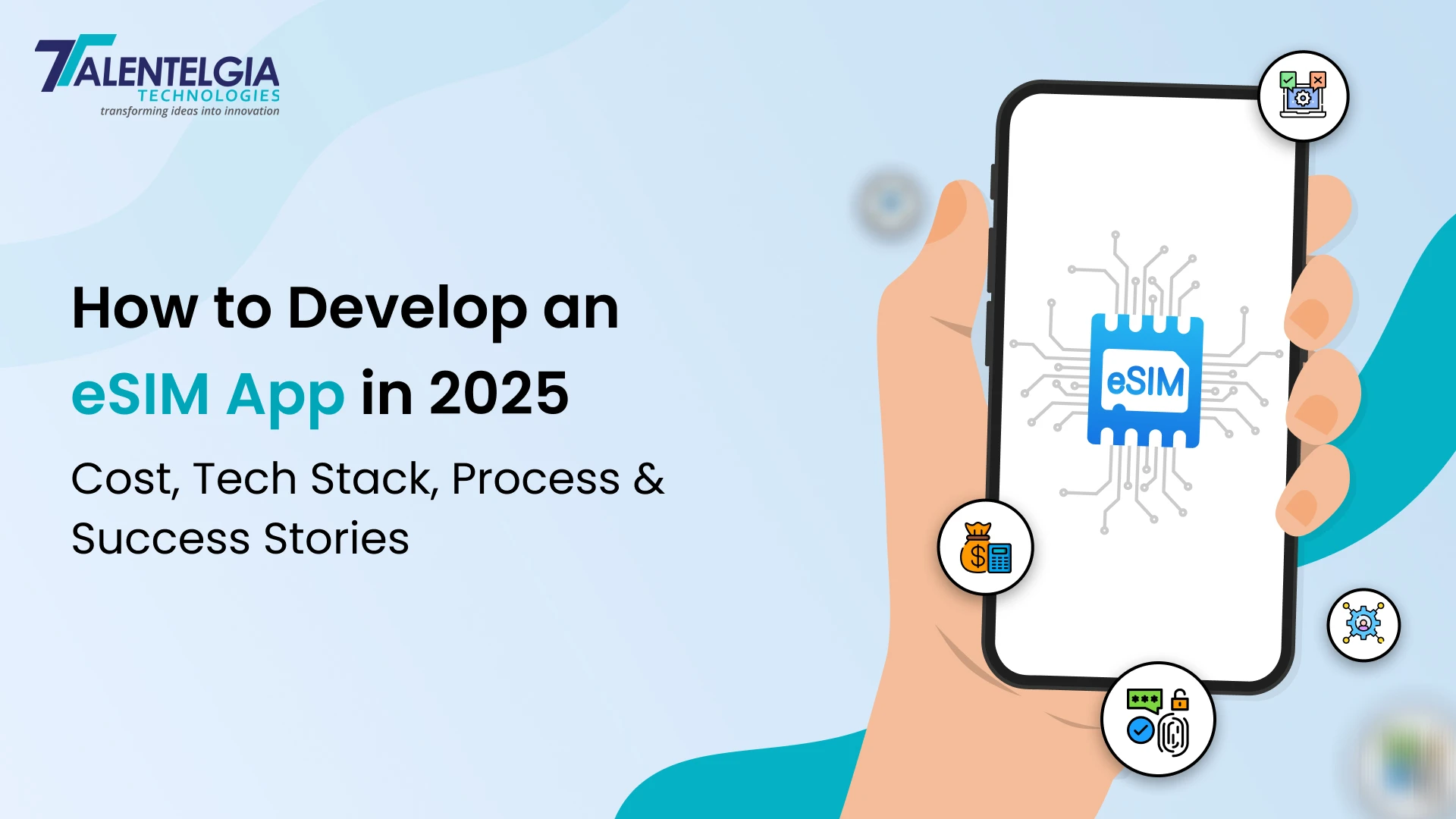

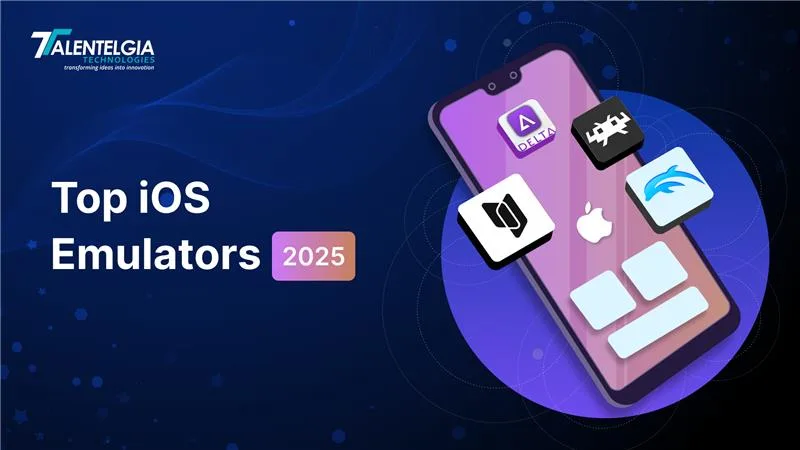

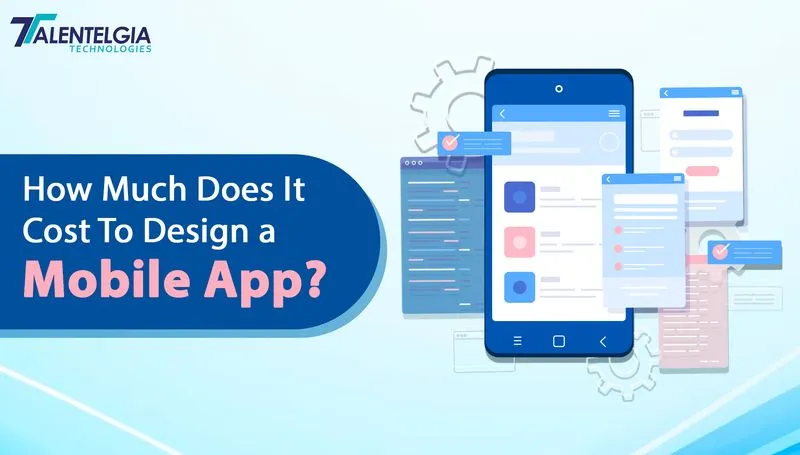












 Write us on:
Write us on:  Business queries:
Business queries:  HR:
HR: 




